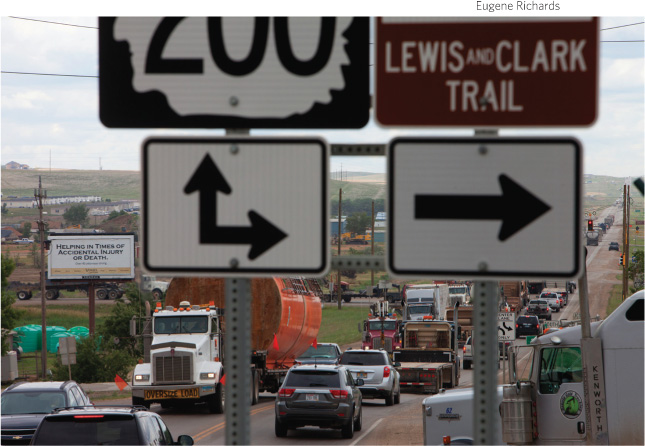Oil consumption drives extraction.
Not all countries use energy equally. Until recently, the United States, for instance, used more energy than any other country. Its overall primary energy use tripled from 1949 to 2009, according to the EIA. In 2009, China surpassed the United States as the biggest consumer of energy, though on a per capita basis, the United States still leads the way, with each person using roughly three times as much energy as the average person in China. Most of this energy comes from fossil fuels—coal, oil, and natural gas, with crude oil as the dominant source. The Houston oil field services company Baker Hughes Inc. estimates that as of February 2011, the United States had 1,713 conventional rigs searching the country for oil or gas. Nevertheless, we import most of what we use: In 2012, the United States produced only 12.4% of the world’s oil but consumed 20.6% of it, importing much of our oil from Canada, Venezuela, and Saudi Arabia.
“You have to keep drilling and drilling and drilling just to keep your production in the same place.” —Raymond T. Pierrehumbert

The good news is that in the United States, oil consumption is decreasing, according to a 2009 report from IHS Cambridge Energy Research Associates. The report predicts that because of changing demographics and improved vehicle efficiency, U.S. oil use peaked in 2005 and is now in decline. But in developing countries such as China and India—the world’s second- and fourth-largest consumers of oil, respectively (with Japan coming in third)—oil consumption is still rapidly increasing, forcing the United States and other countries to extract as much oil as possible, regardless of the consequences.
Our economy and lifestyle are dependent on access to affordable energy, or energy security. Yet there are many reasons that our energy supplies might become unreliable or unaffordable. These include dwindling supplies, increasing demand, dependence on energy imports from politically unstable countries or those that might stop exporting energy resources to us for political reasons, competition from other countries, and a cartel or monopoly increasing prices or decreasing oil supplies.
energy security
Having access to enough reliable and affordable energy sources to meet one’s needs.
In the United States, many of these problems already exist. As supplies dwindle and global demand continues to increase, easily extracted oil becomes less available, forcing companies to use more powerful and costly—and potentially more dangerous—technologies.
KEY CONCEPT 19.9
Accessing unconventional oil and natural gas reserves will not address long-term energy needs, but it may buy time to transition to more sustainable sources of energy.
To be sure, how to best meet our future energy needs is a wicked problem—we need an abundant, reliable source of energy to power our societies. (See Chapter 1 for more on wicked problems.) But each choice comes with its own trade-offs. Phasing out the use of fossil fuels would certainly cut down on air pollution, climate change, and myriad other environmental problems. But the costs and availabilities of various non—fossil fuel sources, in some cases, make them less than ideal alternatives. Even by choosing the best of our admittedly problematic fossil fuel choices (and which is best is debatable), are we just delaying our transition to a carbon-free energy society? A lot is at stake in this wicked problem—huge investments and even bigger profits, the health and well-being of human communities and ecosystems, and the need to keep society running smoothly without facing an energy shortfall.

So how do we increase our energy security and reduce our dependence on fossil fuels so that we can avoid using dangerous extraction methods? There are many possibilities, but two important strategies are diversification and conservation. We can focus efforts on acquiring a variety of domestic sources of energy (including alternative fuels such as biofuels) and importing energy from multiple suppliers. At the same time, we can reduce energy needs through increased conservation and energy efficiency. (See Chapter 23 and Launchpad Chapter 32 for more on alternative energy sources and energy efficiency.) Iceland, for instance, is increasing its energy security by focusing on energy independence, such that it will meet all of its energy needs without imports by the year 2050.
In April 2014 the Bakken oil fields of western North Dakota reached a milestone: They yielded up their billionth barrel of crude oil. Only time will tell how many more barrels remain to be harvested and over how many more years. In the meantime, the greatest gift of Bakken may be the time it buys us to develop other domestic energy sources. “It will only do us good if we use this transitional period wisely,” says Pierrehumbert. “We’re in for a hard landing if we don’t use our current prosperity to pave the way for a secure energy and climate future.”
Select References:
Dobb, E. (2013). America strikes new oil. National Geographic, 223(3): 28–59.
Hughes, J. D. (2013). A reality check on the shale revolution. Nature, 494(7437): 307–308.
Jackson, R. B., et al. (2013). Increased stray gas abundance in a subset of drinking water wells near Marcellus shale gas extraction. Proceedings of the National Academy of Sciences, 110(28): 11250–11255.
Kelly, E. N., et al. (2010). Oil sands development contributes elements toxic at low concentrations to the Athabasca River and its tributaries. Proceedings of the National Academy of Sciences, 107(37): 16178–16183.
Keranen, K. M., et al. (2014). Sharp increase in central Oklahoma seismicity since 2008 induced by massive wastewater injection. Science, DOI:10.1126/science.1255802.
Malakoff, D. (2014). The gas surge. Science, 344 (6191): 1464–1467.
Stolstad, E. (2014). Will fracking put too much fizz in your water? Science, 344 (6191): 1468–1471.
PERSONAL CHOICES THAT HELP
Environmental and health concerns that surround our acquisition and use of fossil fuels continue to grow as we dig deeper and use more extreme methods to obtain oil and natural gas, highlighting our dependence on nonrenewable energy resources. By decreasing our oil and natural gas use, we can reduce the pressure on oil companies to pursue sources of oil that have a greater potential for environmental damage such as deep-water drilling or oil and natural gas deposits like those in the tar sands and shales.
Individual Steps
•Minimize your fuel use when driving by planning ahead to condense shopping trips and errands and reduce total miles driven and by parking as far as you can from your entrance and getting some exercise instead of wasting gas. Try not driving: See where you can safely walk, bike, or use public transport.
•Reduce your use of disposable plastics like water bottles and single-serve food containers and always recycle plastics when possible.
•Turn down your thermostat in the winter to reduce your energy use.
Group Action
•Organize a carpool system in your community to reduce the number of single-passenger car trips.
•Organize a screening of a documentary on energy such as Tipping Point: The Age of the Oil and Sands, Gasland or Gasland 2, or FrackNation. Discuss the positions presented and evaluate the evidence given in support of claims that are made. Do you detect any bias?
Policy Change
•Work with your school’s administration to encourage public transportation and increased bike usage on your campus.
•If you live in a state where fracking occurs, research fracking regulations in your state and voice your opinion about existing or proposed regulations.
